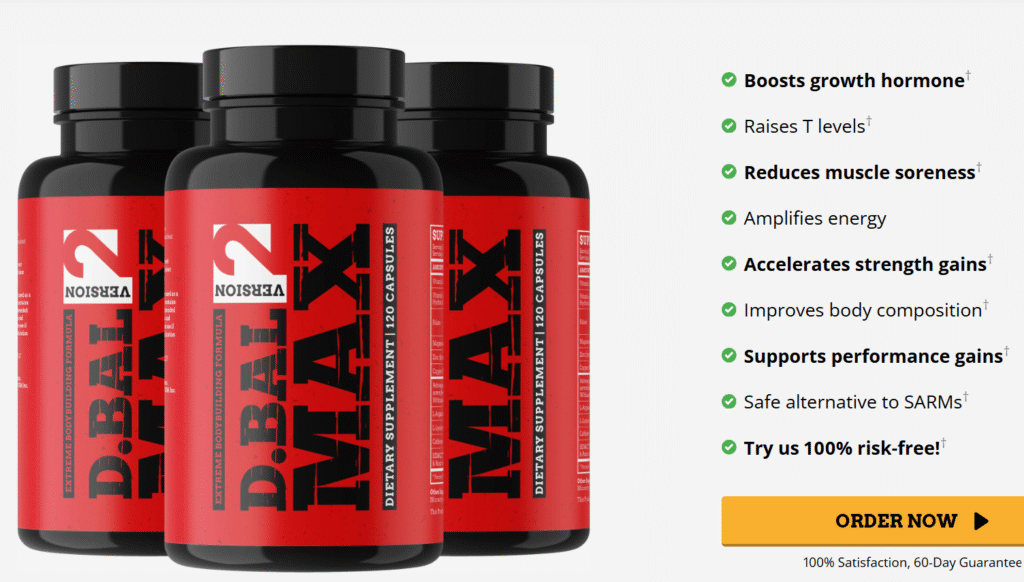
Dianabol (D-Bol) Pills Explained: The OG Mass Builder, Risks, Benefits & Side Effects Read Before Use?
A steroid that never loses its grip on the bodybuilding community is Dianabol, aka Dbol. The anabolic substance encompasses a glorified history as celebrities like Arnold Schwarzenegger publicly admitted using Dbol pills for bigger gains.
Dianabol is one of the most dependable steroids in history offering incredible promise to mass gainers and athletes. The anabolic steroid primarily works to jack up muscle gains and build dramatic strength in a record time.
How often do we relate anabolic steroids to fitness enthusiasts and sportsmen in general? Indeed, more often than not!
This is because these substances have been contributing to their muscle-building and fat-loss goals for not just years but decades.
Yes, anabolic steroids appear to be some bodybuilders’ go-to. Due to their testosterone-related properties, these artificial steroid hormones are common inclusions in fitness regimens.
Through this write-up, let’s learn the nitty-gritty of the Dbol steroid, covering areas like its dosages and results. By the end, you may probably learn about the hype surrounding Dianabol and the potential dangers it carries. Click here to read more about the best Dbol Steroid pills official website.
DIANABOLSTEROID
Dianabol is the brand name of methandienone, whose claim to fame is a boost in muscular growth and strength. Belonging to the class of androgenic anabolic steroids, Dbol is the most budget-friendly and valuable inclusion in bulking cycles.
In general, the steroid is available in orally active pills that work to enhance the growth of proteins. It also aids in increasing some key amino acids that support the muscle regeneration process, useful for muscle growth.
Now, unlike the many types of steroids in the performance-enhancing drug market, Dianabol is not only popular for muscle growth. As it also contributes to fat loss and the accumulation of energy in the form of glycogen, it is equally found in the good books of general dieters and athletes.
Yes, Dianabol equally serves as a performance booster and fat burner, which is reasonable given its versatile nature.
IS DIANABOL LEGAL?
D-bol is the creation of CIBA Pharmaceuticals. After entering the market in 1955, it made the most noise in the bodybuilding community due to aggressive marketing.
Essentially, Dianabol came across as a substance that was heavily contributing to the key goals of bodybuilders. And so, this spark in its popularity was justifiable on several grounds.
As of today, Dbol is no longer promoted or encouraged for recreational purposes, including physique or performance enhancement. This is because of its tendency to generate androgenic and anabolic complications, the worst of which is liver damage.
Yes, as soon as its negative aspects came to light, the Food and Drug Administration came into action, causing a ban on Dbol.
The US and UK treat it as a controlled drug, except for some countries like Mexico, which sell Dianabol over the counter.
Despite its legal landscape and potential to induce side effects, nothing has undone its appeal in bodybuilding to date.
DIANABOL CYCLE
As per bodybuilding experts, a Dbolcycle may be extremely potent and effective, but it can be harsh on beginners. It may jeopardize the health of the liver while raising the cholesterol levels.
Hence, they can rather kick-start their journey with testosterone for a safer experience first.
If not, they need to be extra responsible with the concentration and dosing criteria.Through that, these beginners can pack on somewhere around 30 pounds in their first Dianabol cycle.
There will be massive improvements in strength encompassing 50+ pounds on compound lifts through the steroid.
- Beginners: To ensure safety and the utmost effectiveness, a standard cycle should continue for a 5 week span and not more. During the first 2 weeks, they can consume 10 mg/ day and switch to 15 mg for the next 2. In the last week, they can take a slightly higher dose of 20 mg a day
- Mid-level: Mid-level fitness freaks belong to the category with a former experience with Dianabol. Experts believe that these individuals are more tolerant to Dbol as compared to beginners. And so, can follow a six week cycle starting with a 20 mg dose a day for 2 weeks. For the remaining 4 weeks, however, they can dose at 25 mg a day
- Pros and advanced: As a pro with the experience of many steroid cycles “under your belt”, you follow a longer Dbol cycle. It can be of 8 weeks, starting with 50 mg a day and increasing the strength with time
Overall, Dianabol can give you serious gains in areas like muscle growth and strength. It holds the power to activate and pace up the metabolism, which indicates its properties to burn fat as well.
However, it is more of a muscle booster that bodybuilders and mass gainers resort to for their bulking cycles.
DIANABOL CYCLE DOSAGE
The standard cycle of Dianabolsteroids is 4 to 6 weeks. Yet, expert-level enthusiasts can extend the duration to a maximum of 8 weeks. During this course, amateurs can follow a dianabol cycle dosage of 10 mg a day.
They can go up to 20 mg a day by the end of the course. A dosage higher than this can cause a serious strain on the liver, so they should strictly avoid it.
Alternatively, mid-levels can begin with a higher strength, say 20 mg a day, and go up to 25 mg a day. Since the bodies of experts are familiar with steroids, they are likely to tolerate more and for a longer time.
Hence, their dosing criteria are not as strict, with 50 mg a day and more by the end.
Overall, Dianabol entails a high anabolic index that gives the steroid its unbeatable muscle-building powers. However, bear in mind that no limitations in terms of duration or strength can prevent Dianabol from generating side effects.
The substance can cause hormonal imbalance, depression, jaundice, and more serious complications such as stroke and heart attack.
DIANABOL CYCLE BEFORE AND AFTER
Let’s put this straight: Dbol pills give you a serious transformation and the level of bodybuilding aesthetic you desire. If we overlook its flip side for a moment and exclusively focus on Dianabol results, we will agree that it is, in fact, a promising substance for bulking progress.
Individuals that follow the Dianabol cycle claim to gain some 30–35 lbs. of weight in a 6-week cycle. However, considering the aromatase enzyme, some of this weight could be from water retention.
Moreover, as it enhances free testosterone and glycogenesis, the improvements you experience in your physical strength and power are also exemplary. This surge in stamina can greatly support your sports performance as well as the aggression you need in your training.
As per user reviews, the steroid also eliminates subcutaneous fat as part of its overall recomposition effect. If we delve into its mechanism to learn how a potent muscle booster like Dbol can equally facilitate fat loss, we will reach two conclusions.
Number one, it boosts protein synthesis, which influences the pace of metabolism. Furthermore, because Dianabol is an exogenous testosterone, it can act as a fat-burning hormone for you!
DIANABOL RESULTS AFTER 2 WEEKS
Generally, the typical Dianabol cycle lasts for up to 6 weeks. But it’s natural for users to wonder what they can expect in a two-week span.
Essentially, do not expect anything significant at this stage as it is too early, to say the least. But yes, D-bol does kick in in a matter of days, causing a difference in some fitness areas.
For example, a growing surge in strength and energy that builds your endurance for your grueling workouts. This surge escalates with the passage of time, allowing you to lift your progressive overload levels.
Moreover, you will notice your muscles healing at a rather faster pace than before. It is because Dbol builds more protein in the body, and protein aids in the muscle recovery process.
As for muscle gains, there is a chance of hitting the 4-6 lb. growth mark. However, that depends on your efforts and the quality of the regimen you are following.
HOW QUICKLY DOES DIANABOL WORK?
In comparison to other AAS, the anabolic steroid has a relatively short half-life, say 5 hours. However, it is impossible to say for certain how quickly you will see results.
Remember, human biology may seem easy to understand, but it is far more complex. Furthermore, there are other factors to consider, such as the intensity and duration of your workouts, how strictly you adhere to your dietary restrictions, and so on.
So yes, one cannot say for certain, but Dianabol is a fast-acting steroid. Expectedly, it begins to work in a matter of days, not weeks.
However, the improvements become visible to the naked eye after 1.5-2 weeks.
HOW MUCH DIANABOL DO I NEED FOR A CYCLE?
Depending upon your fitness goals, health condition, and fitness level, you can determine the strength of Dbol steroids. Generally, if you aim for a body makeover, 20 mg of Dianabol pills per day will do the job.
This makeover involves muscle hypertrophy and strength gains, giving you that bodybuilder aesthetic and feel. However, your standard cycle should not go beyond the 6-week mark, as Dianabol is dangerous. And you have no margin to take that risk!
WHAT DOES DIANABOL DO TO YOUR BODY?
Dianabol synthetic hormone that puts you in an anabolic state through binding to the androgen receptors.
This anabolic response activates nitrogen retention and protein synthesis, which are two crucial processes contributing to muscle development.
Basically, these processes lead to a higher stock of protein that the body begins to make. And protein assists in the muscle regeneration process, wherein the affected muscle fibers recover and multiply after intense workouts.
This building and reproduction of muscle fibers leads to the desired muscle expansion and increased strength.
Dianabol steroids also help to improve the utilization of dietary carbs. It puts the metabolism into overdrive and gives you an overall recomposition effect.
WHAT CAN I EXPECT FROM DIANABOL CYCLE?
Dbol is powerful and so, expecting anything less from it (including side effects) is not right. Throughout your Dianabol cycle, you can anticipate a higher muscular growth that appears drastic and not average.
You will get in a position to break through your 1-rep max by the indomitable strength running in your veins. There will be a reduction in subcutaneous fat but yes, there could be fluid retention too.
DIANABOL CYCLE RESULTS
The overall Dianabol cycle results are tremendous yet equally intimidating. There is something the steroid offers in every area of your fitness from your endurance to fat loss.
But primarily, there are bigger changes for enthusiasts counting on Dianabol for mega muscle mass. Essentially, the bulking substance promotes the growth of protein that has a great say in the muscle recuperation process.
So, you can look ahead to a significant transformation in how your muscles look before and after. In simple words, you can observe:
- A higher muscle growth (30-35lbs in a 6 weeks course)
- Record strength that leads to dynamic workouts and athletic performance
- Reduction of fat levels (but increase in water weight)
DIANABOL AND DECA DURABOLIN CYCLE STACKING RESULTS
This stacking option was inspired by Arnold’s bulking regimen and is said to be his trademark! As per experts, no other steroid balances Dianabol better than Deca, owing to its mild anabolic nature.
The duo works together to influence the strength and endurance level from high to exemplary. In general, the cycle lasts ten weeks, with Nandrolone (Deca) at 400 mg per week and Dianabol beginning in the third week at 10 mg daily dose and gradually increasing to 20 mg daily for the remaining six weeks.
TEST AND DIANABOL CYCLE STACKING RESULTS
Considering their potent profile, this combination does not suit amateurs and is only for the pros. Now, Dianabol is very similar to testosterone but is particularly effective in areas like serious muscle-building.
On the contrary, testosterone too, encompassesgreat muscle-building potential; it works better for leaner muscles and strength gains.
The recommended duration of the Dianabol and testosterone stack is 10 weeks. During this time, users should begin with 200 mg of testosterone (weekly) for the first week. They can then take 400 mg (weekly) for the next 4 weeks and 500 mg for the next 4. They can take a reverse gear with 200 mg (weekly) for the last week.
When it comes to Dianabol, it is critical to start with 10 mg per day in the third week. They can continue the remaining cycle with 20 mg a day.
DIANABOL AND ANADROL CYCLE STACKING RESULTS
Another powerful and fast-acting stacking option for advanced-level mass gainers is Anadrol and Dianabol. The former is essentially available in oral pills as Dianabol but is just as dangerous.
The fusion of these AAS promises incredible gains in muscle bulk and strength during and after the standard 6-week cycle. The recommended dose of Dianabol during the entire period is 30 mg a day.
As of Oxymetholone (Anadrol), a 50 mg per day dosage for 3 weeks and 75 mg per day for the remaining 3 is the best bet.
WHERE TO BUY DIANABOL STEROIDS?
To buy Dianabol in its pure and most authentic concentration, you should only trust the official website. D-BAL MAX and Crazy Bulk are the top companies selling the best anabolic dianabol steroid alternative pills called “D-Bal”.

This is because it is a high-demand product that is prone to dilution. Hence, trusting the official manufacturers to buy Dbol is one smart move for your bodybuilding goals!
Affiliate Disclosure
The links contained in this product review may result in a small commission if you opt to purchase the product recommended at no additional cost to you. This goes towards supporting our research and editorial team and please know we only recommend high-quality products.
Disclaimer
Please understand that any advice or guidelines revealed here are not even remotely a substitute for sound medical advice from a licensed healthcare provider. Make sure to consult with a professional physician before making any purchasing decision if you use medications or have concerns following the review details shared above. Individual results may vary as the statements made regarding these products have not been evaluated by the Food and Drug Administration. The efficacy of these products has not been confirmed by FDA-approved research. These products are not intended to diagnose, treat, cure or prevent any disease.


